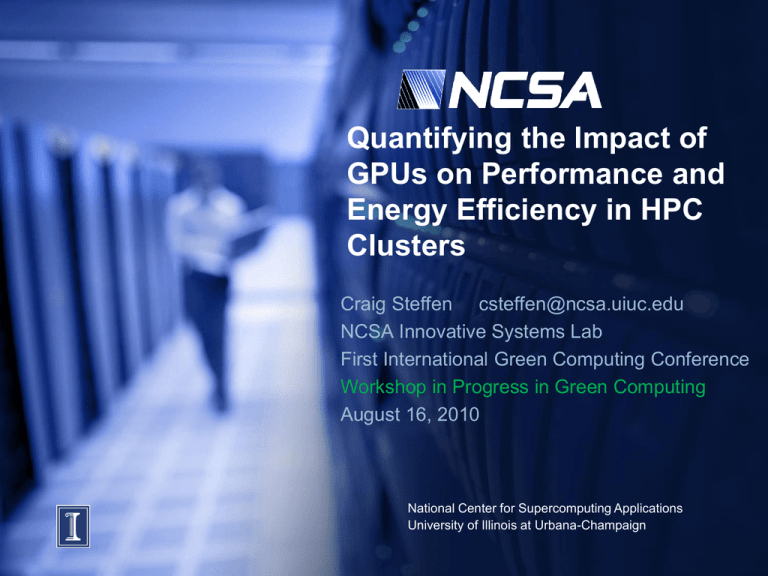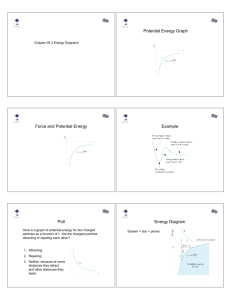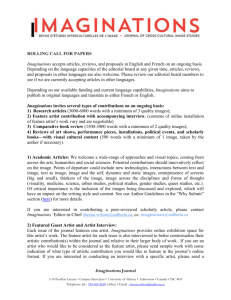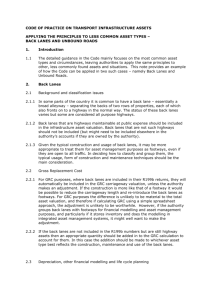Presentation Title - Theoretical Biophysics Group
advertisement

Quantifying the Impact of GPUs on Performance and Energy Efficiency in HPC Clusters Craig Steffen csteffen@ncsa.uiuc.edu NCSA Innovative Systems Lab First International Green Computing Conference Workshop in Progress in Green Computing August 16, 2010 National Center for Supercomputing Applications University of Illinois at Urbana-Champaign Cast of Characters • Jim Philips and John Stone: Theoretical and Computational Biophysics Group, Beckman Institute, UIUC • Kenneth Esler: NCSA and UIUC Physics • Joshi Fullop: NCSA Systems Monitoring • Jeremy Enos, Volodymyr Kindratenko, Craig Steffen, Guochun Shi, Mike Showerman: NCSA Innovative Systems Laboratory Imaginations unbound Overview • AC GPU computing cluster • Power monitoring • Search for power monitors • Roll our own--version 1: Tweet-A-Watt • Roll our own--version 2: Arduino-based power monitor • Current power monitoring on real applications Imaginations unbound AC cluster (Accelerator Cluster) • Originally “QP” cluster for “Quadro Plex” • 32 HP XW9400 nodes. Each node: • 2 dual-core 2.4 GHz Opteron 2216 • 8 GB RAM per node • NVIDIA Tesla S1070 each: • 4 Tesla C1060 GPUs (128 total in cluster) • Interconnect network is QDR Infiniband • CUDA 3.1 compiler/build stack • Job control/scheduler Moab • Specific resource management for jobs via Torque • QP first commissioned November 2007 • AC on-line since December 2008 Imaginations unbound AC Cluster AC01-32 nodes • HP xw9400 workstation • 2216 AMD Opteron 2.4 GHz dual socket dual core • 8GB DDR2 in ac04-ac32 • 16GB DDR2 in ac01-03, “bigmem” on qsub line • PCI-E 1.0 • Infiniband QDR • Tesla S1070 1U GPU Computing Server • 1.3 GHz Tesla T10 processors • 4x4 GB GDDR3 SDRAM • 1 per host IB QDR IB HP xw9400 workstation PCIe x16 PCIe x16 PCIe interface PCIe interface T10 T10 T10 T10 DRAM DRAM DRAM DRAM Tesla S1070 AC cluster used for • Virtual school for Science and Engineering (attached to the Great Lakes Consortium for Petascale Computing) NVIDIA/CUDA August 2008,2009,2010 • Other classes in 2010: • • • • “Intro to CUDA” Volodymyr Kindratenko, Singapore June 13-19 Barcelona Spain, Wen-Mei Hwu July 5-9 Thomas Scavo July 13-23 “Proven Algorithmic Techniques for Many-core Processors” Thomas Scavo August 2-6 • John Stone August 7-8 Imaginations unbound AC GPU Cluster Power Measurements State Host Peak (Watt) Tesla Peak (Watt) Host power factor (pf) .19 Tesla power factor (pf) power off start-up pre-GPU use idle after NVIDIA driver module unload/reload(1) after deviceQuery(2) (idle) GPU memtest #10 (stress) after memtest kill (idle) after NVIDIA module unload/reload(3) (idle) VMD Madd NAMD GPU STMV NAMD CPU only ApoA1 NAMD CPU only STMV 4 310 173 173 10 182 178 178 .98 .98 .96 .96 173 269 172 172 365 745 367 367 .99 .99 .99 .99 .99 .99 .99 .99 268 321 322 324 598 521 365 365 .99 .97-1.0 .99 .99 .99 .85-1.0(4) .99 .99 .31 1. Kernel module unload/reload does not increase Tesla power 2. Any access to Tesla (e.g., deviceQuery) results in doubling power consumption after the application exits 3. Note that second kernel module unload/reload cycle does not return Tesla power to normal, only a complete reboot can 4. Power factor stays near one except while load transitions. Range varies with consumption swings Search for Power Monitors: What questions do we want to answer? • How much power do jobs use? • How much do they use for pure CPU jobs vs. GPUaccelerated jobs? • Do GPUs deliver a hoped-for improvement in power efficiency? Imaginations unbound Hardware: Criteria for data-sampling device • Cheap • Easy to buy/produce • Allows access to real data (database or USB, no CDinstalled GUIs) • Monitors 208V 16A power feed • Scalable solution across machine room (one node can collect one-node’s data) Imaginations unbound Search for Good (and Cheap) Hardware Power Monitoring • Laboratory units too expensive • Commercial Units: • 1A granularity? • No direct data logging • No real-time data logging Imaginations unbound Very capable • PS3000 PowerSight Power Analyzer $ 2495.00 Imaginations unbound Capable; Closer but still too expensive • ElitePro™ Recording Poly-Phase Power Meter Standard Version consists of: • US/No. America 110V 60 Hz Transformer • 128Kb Capacity • Serial Port Communications • Indoor Use with Crocodile Clips • Communications Package (Software) and Current Transformers sold separately. • More Information Price: $965.00 Part Number: EP Imaginations unbound Instrumented PDUs: poor power granularity • 1A granularity • 120V circuits Imaginations unbound Watts-up integrated power monitor: CLOSE • Smart Circuit 20 31298 $194.95 • Outputs data to web page (how to efficiently harvest this data?) Imaginations unbound Data Center Power—208 V, 20 or 30A Imaginations unbound Power Monitoring Version 1: Tweet-a-Watt Receiver and Transmitter http://www.ladyada.net/make/tweetawatt/ Kits available from www.adafruit.com Imaginations unbound Tweet-a-Watt • Kill-a-watt power meter • Xbee wireless transmitter • power, voltage, shunt sensing tapped from op amp • Lower transmit rate to smooth power through large capacitor • Readout software modified from available Python scripts to upload sample answers to local database • We built 3 transmitter units and one Xbee receiver • Currently integrated into AC cluster as power monitor Imaginations unbound Evaluation of Tweet-a-Watt • Limited to Kill-a-Watt capability (120V, 15A circuit) • Low sampling rate (report every 2 seconds, readout every 30 seconds) • Either TWO XBEE units required or scaling issue • Fixed but configurable program; one set, difficult to program (low sampling rate means unit is off most of the time) • Correlated voltage and current (read power factor and true power usage) • 50-foot plus range (through two interior walls) • Currently tied to software infrastructure: Application power studies done with Tweet-a-Watt Imaginations unbound Power Monitor version 2: One-off function Prototype Power Monitor • Used chassis from existing (120 V) PDU for interior space • Connectors, breaker, and wiring to carry 208V 16A power distribution • Current sense transformers and Arduino microcontroller for current monitoring • Prototyped (but not deployed) Python script to insert output into power monitor database Imaginations unbound Arduino-based Power Monitor • Based on Arduino Duemilanove • • • • • • Runs at 16 MHz USB has 6 analog voltage-to-digital converters (sampled explicitly by read() function) Runs microcode when powered on (from non-volatile memory) Accumulates sample arrays for N samples per channel per report (N is on subsequent slides) Accumulates current measurements, computes RMS values, and outputs results in ASCII on USB connection Arduino is powered from the USB connection Imaginations unbound analog inputs MN 220 picking transformer from Manutech • • • • • • Manutech.us 1000 to 1 voltage transformer; 1 to 1000 current transformer Suggested burden resistor: 100 Ohms. AC output voltage proportional to AC current input. Output at 100 Ohms: 100 mV/Amp. Various ranges of output are achievable by using different burden resistors. Imaginations unbound Current Sense Transformer • MN-220 current “transformer” designed for 1 to 20 amp primary • 1000-1 step-up current transformer • Burden resistor sets the sensitivity; sets “volts per count” calibration constant • Allows current monitoring without Arduino contact with high-voltage wires AC Current carrying wire Imaginations unbound Sense wires Industrial Design • • 5 separate sense transformers for 4 power legs and opposite leg of input Current sense ONLY; Arduino is competely isolated from power conductors. No phase or power factor information, RMS current only Current sense transformers Imaginations unbound Interchangeable burden resistors Arduino Arduino development environment • C-like language environment • • • #defines for calibration constants Initial setup() function runs once loop() function repeats forever SPECIAL WARNING: Arduino INTs are 16 bits! Summing the squares of measured voltages (in the 200 to 400 range) will OVERFLOW the accumulator INT. (Convert to float b efore squaring) Imaginations unbound Output Format (our implementation • Every sampling period outputs block of ASCII text to virtual console (accessed under Linux typically at /dev/ttyUSB0) • No protocol or readers necessary; software can be checked with commands tail or more • If ANY sample on a channel is within 10% of the hard limit, then the channel is flagged as “overflow” in the output stream (note the \r \n double-line breaks) Imaginations unbound Calibration, Uncertainty and Readout Speed • Arduino only does RMS summing; not synchronized with AC clock. Possible sampling errors from undersampling AC waveform (hopefully eliminated by enough samples) • Samples-per-report is set high enough to minimize undersampling errors • Uncertainty measured with idle node (upper uncertainty limit only) Measurements per report Time between reports (s) Uncertainty (mA) 250 .28 ±7 125 .2 ±8 60 .15 ±35 Imaginations unbound Industrial design continued • • • Interchangable burden resistors to match pickup transformer output voltage to Arduino voltage sense Initially configured with two 600W channels, two 1000W channels, and main leg monitor is about 3300W for 16A at 208V Conclusion: no advantage to careful matching of burden resistors. Uncertainty of 3300W channel vs. 600W: • • • 250 samples: 6 vs 7mA 125 samples: 8 vs 8 60 samples: 37 vs 35 • Advantage: eliminates a LOT of wiring from the prototype Imaginations unbound Data storage and calibration database • Prolog scripts identify the (one) power monitored node (via Torque) • Job history entry tags job to be attached to time window of power monitor data • The job scripts create an automagic link to graphed output data per-sample and total usage summary Imaginations unbound Power monitor data presentation • http://ac.ncsa.uiuc.edu/docs/power.readme • submit job with prescribed Torque resource (powermon) • Run application as usual, follow link(s) Imagination Unbound Each monitored job shows up as a link at http://ac.ncsa.uiuc.edu/jobs.php Imagination Unbound Power Profiling – Walk through • Mouse-over value displays • Under curve totals displayed • If there is user interest, we may support calls to add custom tags from application Output Graphs Imaginations unbound Job ID Unique Features of this Hardware+Software Setup • Hardware solution • Cheap • Scalable • Presentation integrated with job software • Simple to use with jobs.php link • Not required; can be ignored by other users Imaginations unbound Real Application Speed and Efficiency • Speedup measured in terms of wall clock time for whole application to run • Power consumption measurements made over at least 20 sample runs • Removed power measurements from startup and shutdown phases of applications NOTE: The NVIDIA cards have internal power measuring. We didn’t use them because • That leaves out the power supply of the Tesla • We got inconsistent node-to-node results • We wanted to understand the systematics of the data Imaginations unbound Case Study: NAMD • Molecular Dynamics based on Charmm++ parallel programming environment; contains support for GPU codes • Sample set was “STMV” 1 million atom virus simulation • Performance measure is simulation time step per wall clock time • CPU-only: 6.6 seconds per timestep; 316 Watts • CPU+GPU: 1.1 seconds per timestep; 681 Watts • Speedup: 6 • Speedup-per-watt: 2.8 Imaginations unbound Case Study: VMD • Molecular visualization and analysis tool • Computes 3D electrostatic potential fields, forces, and electron orbitals • Computation problem: 685,000 atom STMV trajectory using multilevel summation method • CPU-only: t=1465 seconds; 300 watts • CPU+GPU: t=58 seconds; 742 watts • Speedup factor: 26 • Speedup-per-watt: 10.5 Imaginations unbound Case Study: QMCPACK • Quantum Monte Carlo for tracking movement of interacting QM particles • Simulating 128-atom simulation cell of bulk diamond, including 512 valence electrons • Caviat: • CPU-only version uses double precision • CPU/GPU version uses mostly single-precision • Results are consistent within result uncertainty • Results reported for Diffusion Monte Carlo; results for variational Monte Carlo are similar • CPU-only: 1.16 walker generations per second • CPU+GPU: 71.1 walker generations per second • Speedup: 62 • Speedup-per-watt: 23 Imaginations unbound Application Case Study: MILC • MIMD Lattice Computation of QCD • MILC calculations must now include electromagnetic effects in the calculations • Problem set 28x28x28x96 lattice • Single-core version only at this time • Computation on single-core vs. single-core+GPU • Power monitoring is for whole CPU node or CPU node+GPU • • • • CPU core: 77324 s CPU+GPU: 3881 s Speedup: 20 Speedup-per-watt: 8 Imaginations unbound performance-per-watt Current State: Speedup to Efficiency Correlation 50 45 40 35 30 25 20 15 10 5 0 300-800 300-600 300-700 0 20 40 60 80 100 speedup factor • The GPU consumes roughly double the CPU power, so a 3x GPU is require to break even • Performance-per-watt is asymptotically roughly half speedup factor or less Imaginations unbound Future Work • Arduino-based power monitor not yet commissioned • Data-collection issues with higher granularity: • Only take data for jobs (no monitoring idle nodes) • User selects sampling rate (high-res power monitoring only when it will be used • Future: user tags application phases to refine data analysis (startup, shutdown, computation, communication) Imaginations unbound HPRCTA 2010 (workshop at SC 2010 in New Orleans) • Fourth International Workshop on High-Performance Reconfigurable Computing Technology and Applications • All day Sunday, November 14 • The workshop is co-organized by the National Center for Supercomputing Applications (NCSA) at the University of Illinois at Urbana-Champaign, the George Washington University, OpenFPGA, and Xilinx • Submissions due September 3, 2010 • http://www.ncsa.illinois.edu/Conferences/HPRCTA10/ • http://tinyurl.com/hprcta2010 Imaginations unbound SAAHPC 2011 • Symposium on Application Accelerators in High Performance Computing 2011 • Covers all accelerators including GPUs, FPGAs, Cell • Co-hosted by NCSA, University of Illinois and University of Tennessee, Knoxville • 2011 dates and location not announced (June or July) • Submissions due in April/May 2011 Current news can be found at: saahpc.org Imaginations unbound








